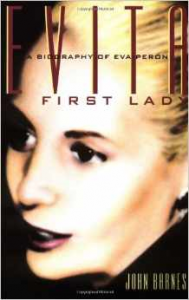 Two iconographic Latina women have remained conversation topics in North America, decades after their deaths. Evita Perón is the one without the mustache. When you visit the Museo Evita, on Buenos Aires’ Calle Latinfur, you get several informative movie clips, an exhibition of her clothing and jewelry, a death mask, and as a finale, a trip you the gift shop where you can buy Evita wine bottles, key chains, and coasters. One film clips describes her foundation, which, among other things, distributed toys to poor children. As expected, there’s nothing negative about Eva Perón in the museum, so one suspects, upon seeing the mask of her desecrated face, that some important information about her life is missing. And in author John Barnes’ Evita First Lady: A Biography of Eva Perón (1978, ISBN 0-394-50289-2) an explanation surfaces. Evita had it in for the rich, whom, as a class, she neither liked nor trusted. And they took their revenge upon her death.
Two iconographic Latina women have remained conversation topics in North America, decades after their deaths. Evita Perón is the one without the mustache. When you visit the Museo Evita, on Buenos Aires’ Calle Latinfur, you get several informative movie clips, an exhibition of her clothing and jewelry, a death mask, and as a finale, a trip you the gift shop where you can buy Evita wine bottles, key chains, and coasters. One film clips describes her foundation, which, among other things, distributed toys to poor children. As expected, there’s nothing negative about Eva Perón in the museum, so one suspects, upon seeing the mask of her desecrated face, that some important information about her life is missing. And in author John Barnes’ Evita First Lady: A Biography of Eva Perón (1978, ISBN 0-394-50289-2) an explanation surfaces. Evita had it in for the rich, whom, as a class, she neither liked nor trusted. And they took their revenge upon her death.
The story of her childhood in a hard-scrabble rural environment is well-known, as is her rise to a degree as social success as a radio and film actress, culminating with her meeting of Colonel Juan Perón and their subsequent relationship and marriage. As Barnes attests, she used her new-found power as the first lady to secure better pay for workers, women’s suffrage, and better living conditions for the poor, backed by the political authority of her husband. Her impatience for social change, fueled by her impoverished background and a sense of evolving her country from rural feudalism, was the driving force, accomplished by virtually any means possible. She was a bully, and never forgot a slight, seeking revenge upon just about anyone that crossed her. She and Perón censored newspapers and controlled radio stations that didn’t adhere to the party line, and disagreement on any level with the Peróns’ approach would guarantee the loss of a favored position or career. Barnes’ book describes what appeared to be a constant flow of disposed intellectuals, oligarchs, and military men from Argentina to new homes across the Rio de la Plata to Uruguay.
The Peróns’ rule had enigmatic facets. Juan Perón was an early supporter of the Nazis and admired Mussolini. Jews were openly threatened, and pro-Perón backers were documented looting Jewish-owned business and beating their owners. And yet, several years later, Evita’s Social Aid Foundation sent shipment of food and clothing to the young state of Israel. The story of the Foundation is a key part of this book. Evita strong-armed individuals, companies, and union organizations to give to her charity. Books were never kept, and the book offers strong hints that Evita’s considerable wardrobe and jewelry collection were bought by the Foundation. And yet, in the eight pages devoted to it, remarkable things were accomplished, from expanded heath care, to schooling, to food programs. To a very great extent, the workings of the foundation contributed to what was increasingly becoming a strong and viable middle class.
What’s all the more remarkable is that she accomplished so much before her death at the young age of 33.
The book is not without criticism. Barnes sees the Perón era as being led by Evita, and characterizes Juan Perón as little more than a facilitator of his wife’s bidding, which we suspect is a simplification of the relationship and the regime. The author, a veteran journalist, arrived in Argentina in 1955, three years after Evita’s death and a year after Perón was overthrown. He eventually became Newsweek’s Latin-American correspondent and published this book several years after that. It covers the strange twist of the fate of her body, secretly buried in Italy, and later returned to Buenos Aires’ Recoleta cemetery, where today, thousands visit her remains in the Duarte family mausoleum. Her body arrived with a broken nose and a slash across her face, a fact unfortunately not mentioned in the book.
What ultimately fascinates us about this book is the woman herself, flawed, angry, impatient, and vengeful, who marshaled her forces, took the bully-pulpit, offended thousands, and managed to change the course of history in her country. Other books will offer a more comprehensive telling of the Perón era, his overthrow, and return. But this one, we feel, offers a real insight into the passions, human failings, and compelling actions of the woman herself. Buy it now at the WoWasis eStore.
Leave a Reply